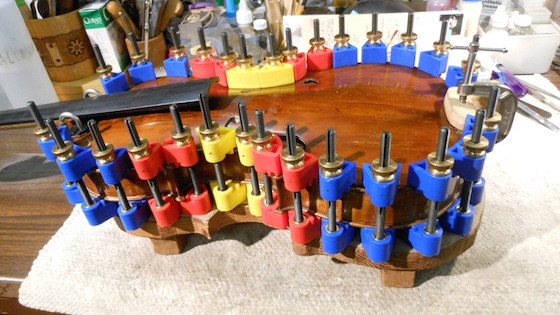V.com weekend vote: How often do you get your violin's seams checked?
A few weeks ago I was visiting the violin shop to get my bow re-haired, and they asked if I wanted to have my violin checked.
I realized that had been a very long time since anyone had really given my violin a good look and checked for open seams.
Indeed it had, and I had some half-dozen openings! The good news is that my fiddle spent a few nights away, and now it sounds absolutely wonderful. Fixing an open seem can make a huge difference in the sound of a violin.

My violin in clamps, from a previous restoration.
What exactly is an open seam? The places where the back and front of the violin are glued to its ribs are called "seams." When they come apart, typically in a small area, then you have an open seam.
So why would seams come apart? The body of the violin is glued together with hide glue, which is intentionally not the strongest glue on earth. When you have different kinds of wood glued together (typically the back of a fiddle and the ribs are maple and the front is spruce) changes in temperature and humidity (due to weather, season, or your hot, sweaty body) can cause the wood to expand and contract at different rates. It's better that the seams occasionally come apart than some kind of SuperDuperGlue keeps them together and forces the wood itself to crack!
So addressing open seams is a regular maintenance issue for violinists, but one that doesn't necessarily get a lot of press. An experienced luthier can detect an open seam just by knocking a bit on the back and front, around the edges. (I had one luthier, back in the day, who used to put the violin up to his mouth and try to blow on the seams, to see if any were open!)
To fix an open seam, a good luthier will clean it out the old glue, apply the hide glue and then let it dry with a clamp on, to keep it closed.
After this experience, my plan is to turn over a new leaf and have my fiddle checked every time I get the bow re-haired, which is usually twice a year. I had waited far too long!
So do you have your violin, viola or cello checked regularly for open seams? How often do you find they need to be fixed? Please participate in the vote and then share your thoughts in the comments. And for any luthiers, you are welcome to share your expertise (no doubt you know more than I do about the topic!)
You might also like:
- Discussion: Seams Opening
- Discussion: What is the procedure of closing open seams?
- Discussion: Violin repairs : when should the top be removed ?
* * *
Enjoying Violinist.com? Click here to sign up for our free, bi-weekly email newsletter. And if you've already signed up, please invite your friends! Thank you.
Replies
I’ve learned to check them myself. It just takes patience and good ears. Steve, I think you’re correct. The other thing that can cause it is by dropping the violin. As they are very dainty, this is to avoided at all costs, of course.
Seams, madam? Nay, it is; I know not seams.
You should check it yourself as regular maintenance. Very simple. Just knock/tap lightly along the outer edge all the way around the top and back of the instrument. Listen for a double impact sound.
A solid seam has a clear single ring to it. Also keep a glue stick very lightly wedged under the fingerboard. This supports the neck pressure and prevents dropping of the fingerboard. Especially essential for higher arched violins. Frequent changes in humidity and temperature can cause problems.(Weather) (Time of year) (Country/State etc.) Going in and out of heated or air conditioned environments can also cause issues.
I check them myself every few months on all my violins, and when I take them to my luthier, he checks them as well. So far in 8+ years I've never had an open seam, except for one instrument that had one when I bought it. I agree with Steve and think open seams usually happen due to humidity and temperature changes; my instruments are always in climate-controlled conditions.
Wot Steve sed. I heard of someone who left a uke on the backseat of his car in the sun. He came back to find it in pieces.
During the pandemic I took my violin to the shop to have my sparkly new Luxitune fine tuner installed and to have a general cleaning. The luthier said, "Sure, I'll install the tuner get your fiddle all cleaned up and close that seam for you" Huh what huh?! I had no clue! When he showed me, it was so obviously open. I was playing gigs on it, traveled back and forth to New York from DC a few times but I'm not exactly sure when it happened. It was an easy enough fix, and though this was the only time in almost twenty years of playing on my beloved fiddle that I've had this issue, I felt so embarrassed and guilty. I now use the Boveda packets and check my seams more regularly.
Andrew, a friend of mine left his ukulele in his car. When he returned, there wer two more there.
Ha ha
This article has been archived and is no longer accepting comments.
Violinist.com is made possible by...
Dimitri Musafia, Master Maker of Violin and Viola Cases
Johnson String Instrument/Carriage House Violins
Subscribe
Laurie's Books
Discover the best of Violinist.com in these collections of editor Laurie Niles' exclusive interviews.

Violinist.com Interviews Volume 1, with introduction by Hilary Hahn

Violinist.com Interviews Volume 2, with introduction by Rachel Barton Pine













October 26, 2025 at 10:36 PM · In my experience over here seams very seldom open spontaneously. I think it's down to the climate.